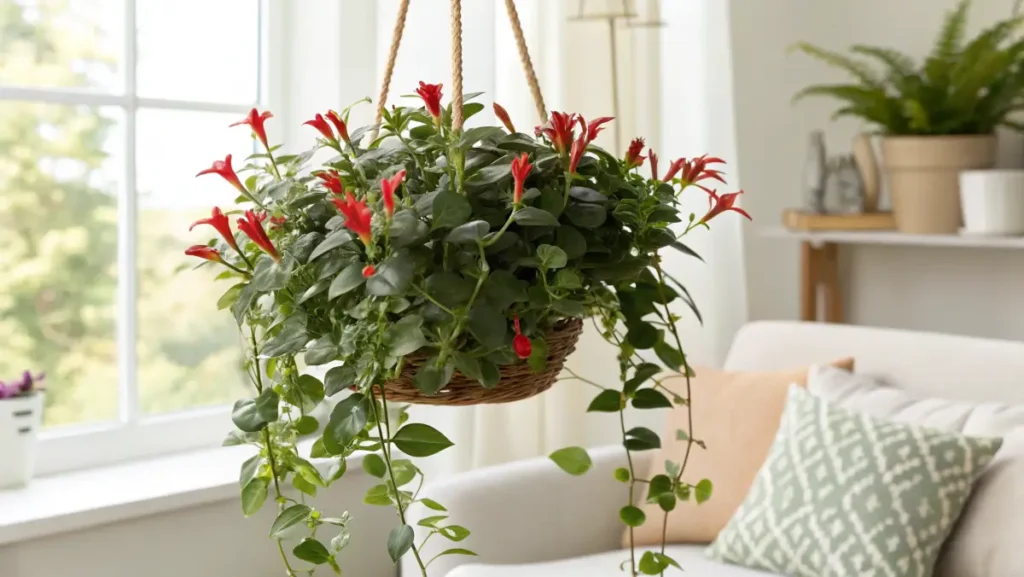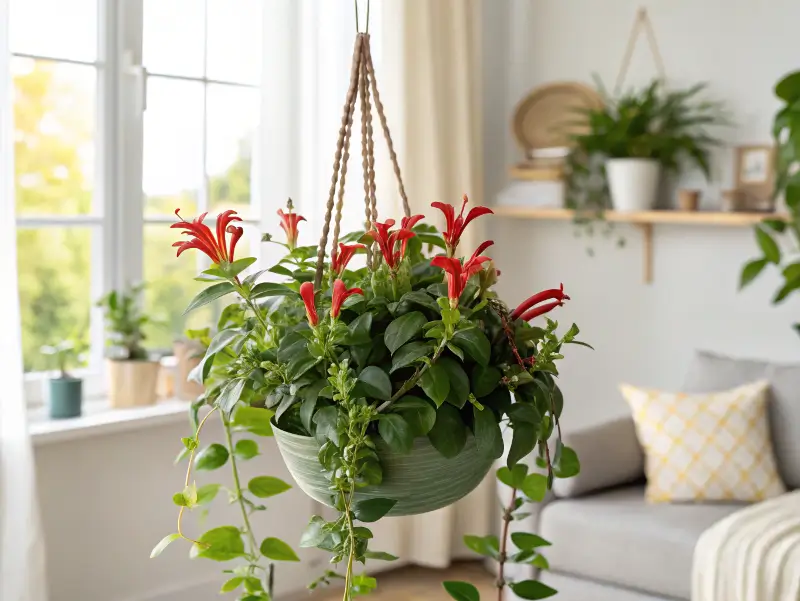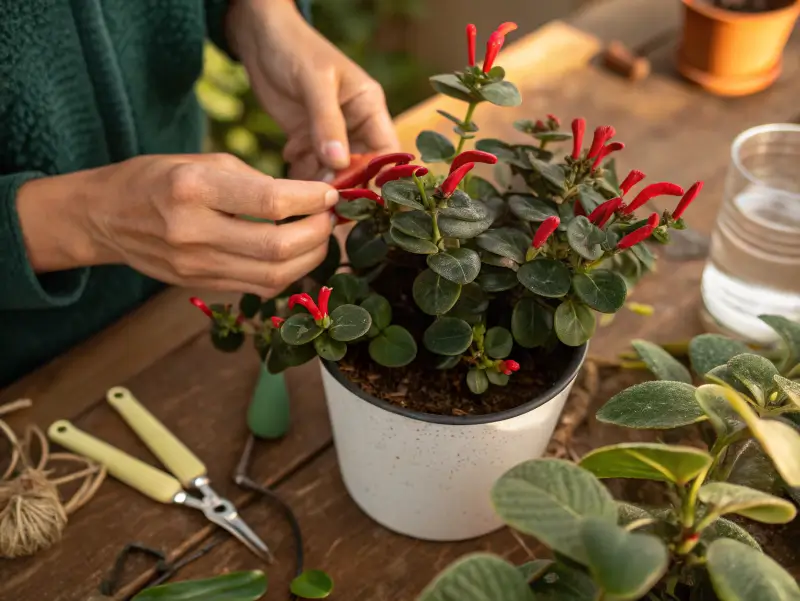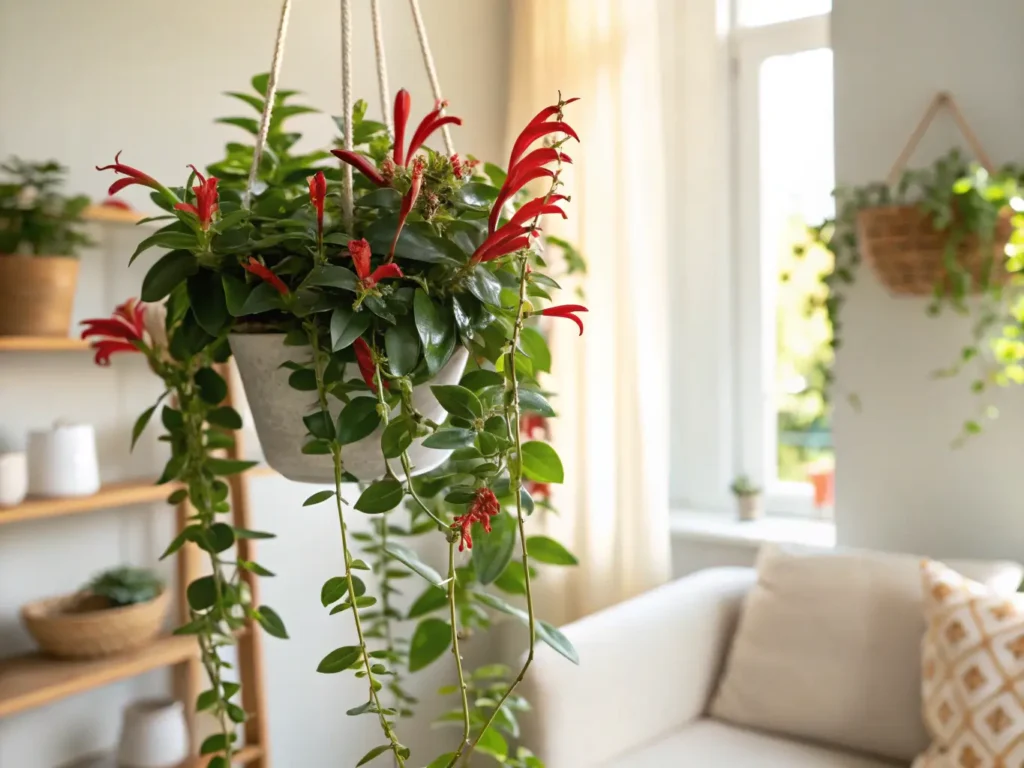
I’ve been hooked on houseplants since last summer, and the curly lipstick plant quickly became a real favorite. This guide covers everything I’ve learned about this striking tropical gem—from different cultivars and no-fuss care routines to troubleshooting and fun styling ideas. Expect handy tips on watering, feeding, picking the perfect light, and more. By the end, you’ll be ready to bring a lipstick curly plant into your space with confidence!
Table of Contents
Introduction to the Curly Lipstick Plant
Understanding the Aeschynanthus radicans ‘Curly’
I’ve always been drawn to the curly lipstick plant—scientifically labeled as Aeschynanthus radicans ‘Curly.’ It’s part of the broader Lipstick Vine clan, which includes cultivars like the Twisted Lipstick Plant and the Black Pagoda Lipstick Plant.
Each spiral leaf pulls you in with a tight coil, and when blooms appear, you’ll see vibrant red or orange flowers shaped like little tubes of lipstick.
- Key Highlights
- Spiraled leaves for that dramatic look.
- Perfect choice for hanging baskets.
- Super easy to grow indoors if you give it moderate care.
These trailing houseplants thrive in tropical environments. When you find them online or at plant stores, you might notice how well-suited they are to both boho-chic homes and bright, modern condos. Folks share awesome pictures of their curly lipstick plant flourishing in living rooms, home offices, even on sunlit patios.
The Rise in Popularity and Google Top 10 Overview
You’ll spot plenty of “How to care” resources popping up for the curly lipstick plant in Google’s top results. Many gardening enthusiasts praise its vibrant leaves, minimal fuss, and, of course, its trendy look on social media.
- Why It’s Trending
- Colorful, quirky foliage.
- Adapts to different lighting.
- Low-ish upkeep schedule compared to other houseplants.
In truth, it’s the perfect “gateway” plant for folks new to botanical bliss.
Curly Lipstick Plant Varieties and Synonyms
Distinguishing Curly vs. Twisted Lipstick Plant
People often ask if the curly lipstick plant differs from the Twisted Lipstick Plant. They’re similar, but the curly version usually features tighter coils on the leaves, while the twisted type spirals a bit more loosely.
- Similarities
- Both belong to the Aeschynanthus family.
- Both boast tube-like flowers.
- Both thrive with warm, humid conditions.
- Small Variations
- Leaf shape differences (curly is often tighter).
- Growth rate can vary slightly.
- Twisted might have slimmer leaves.
Other Names and Synonyms (Lipstick Vine, Aeschynanthus radicans)
Don’t panic if your local nursery only labels it as the Lipstick Vine. Some places even use scientific names like Aeschynanthus radicans ‘Curly.’ Regardless of the label, you’ll still end up with the same dramatic, looping foliage.
- Common Synonyms
- Lipstick Vine
- Lipstick Curly Plant (unofficial)
- Aeschynanthus radicans
If you want to be sure you’re actually bringing home the curly cultivar, snap a pic and compare the coils. Nurseries might have general signage, but photographs help you match the plant.
Benefits of Growing a Curly Lipstick Plant

Ornamental Value and Indoor Aesthetics
I’m all about visual appeal, and the curly lipstick plant delivers a striking look. It hangs beautifully in baskets, adding a lively, playful spirit. Imagine those mesmerizing curled leaves cascading down while little red blossoms pop up here and there.
- Why It’s Beautiful
- Spiraled leaves that stand out.
- Ideal for boho or minimalist decor.
- Bright floral contrast for neutral backdrops.
If you love layering different indoor foliage plants, this one pairs nicely with pothos or philodendrons. I’ve hung mine in a corner of my living room to replace a lonely lamp. Instant color boost!
Air-Purifying Qualities and Well-Being
Some people say the curly lipstick plant can help purify indoor air. Whether or not it singlehandedly cleans your entire house, it’s still beneficial to have lush greenery around. Studies often show a positive link between caring for plants and stress relief.
- Potential Perks
- May help with general air freshness.
- Promotes a calm environment.
- Encourages mindful routine when you water and prune.
Even if it’s not as famed as snake plants for purifying air, it sure does bring good vibes.(For those who want an official stance on indoor gardening, you can check the USDA Plants & Environment website for basic guidelines.)
Ideal Growing Conditions for Curly Lipstick Plants
Light Requirements: Sun vs. Shade
Wondering if the lipstick curly plant enjoys direct sun or shade? In my experience, it thrives in bright, indirect light. A place near a window that gets some gentle morning rays or late-afternoon glow is perfect.
- Light Tips
- Avoid harsh midday sun.
- Rotate the plant occasionally for even growth.
- Supplement with grow lights if you have short winter days.
Too much shade leads to fewer blooms, and direct scorching sun can brown those neat leaves. Strike a balance, and you’ll see consistent flowering.
Soil Composition and Watering Needs
I suggest a well-aerated mix. You can mimic tropical houseplant care by combining potting soil, perlite, and maybe a little orchid bark.
- Soil Mix
- One part potting mix
- One part perlite (or coarse sand)
- Optional: a sprinkle of orchid bark or coco coir
Water only when the top inch of soil feels dry. If you keep it soggy, you risk root rot. I like using the “finger test” or a moisture meter to be sure I’m not drowning my plant.
- Watering Guide
- Check soil dryness every 4–7 days.
- Thoroughly water, then let excess drain.
- Reduce frequency in cooler months.
Humidity helps, so consider a pebble tray below the pot or group it with other humidity-loving companions.
Best Practices for Curly Lipstick Plant Care

Fertilizing, Pruning, and Maintaining Healthy Foliage
Keeping up with curly lipstick plant care can be straightforward if you follow a monthly feeding schedule during spring and summer. I prefer a balanced water-soluble fertilizer, diluted according to the label. This ensures those curly leaves keep their lush green and the plant invests energy in producing those lipstick-like blooms.
- Feeding Routine
- Monthly in warm seasons.
- Every other month in fall.
- Skip feeding in winter if growth slows.
Pruning time is after the flowering stage. Snip the tips of leggy vines to encourage branching. Trust me, a little trim does wonders for shaping your trailing friend. Keep your scissors or pruning shears clean to avoid spreading diseases.
- Pruning Benefits
- Encourages compact growth.
- Removes dead or yellowing leaves.
- Helps shape the plant for a fuller look.
Watch for leaves turning yellow or drooping—common signs you might be overwatering or under-lighting. Adjust accordingly and your foliage should bounce back.
Repotting and Propagation Techniques
If roots circle the pot or pop out of drainage holes, it’s time to give your lipstick curly plant a new home. Go one size up with the container so it doesn’t get overwhelmed with too much extra soil.
- Repotting Steps
- Gently loosen the root ball.
- Position in a new pot with fresh mix.
- Water lightly and let it settle for a day or two.
Propagation is fun and easy. Cut a healthy stem just below a node, remove lower leaves, and place in either water or moist soil. Watch for roots to form, then pot it up. Soon enough, you’ll have another curly lipstick plant to show off.
Common Problems and Solutions for the Curly Lipstick Plant
Identifying Pests and Diseases
Some days, I’ll spot mealybugs hanging around fuzzy leaf joints or spider mites spinning webs in dry conditions. This can happen if humidity is too low or if the plant sits in a dusty corner. A quick swipe with neem oil or insecticidal soap usually tackles these bugs.
- Pests to Watch Out For
- Mealybugs (white cottony clusters)
- Spider mites (tiny specs with webbing)
- Scale (hard-shelled, brownish pests)
Root rot prevention is also critical. If your plant is drowning in soggy soil, you’ll see limp leaves and dark, mushy roots. Trim off damaged areas and switch to a well-draining medium.
Effective Troubleshooting and Prevention
Check your plant regularly. If you catch issues early, it’s easier to fix.
- Troubleshooting List
- Yellow leaves → Overwatering or poor light
- Few or no blooms → Not enough indirect sunlight
- Wilting stems → Possibly underwatering or root rot
A monthly routine of cleaning leaves with a damp cloth can also prevent pest infestations. That extra care can save you a lot of frustration down the line.
Styling and Decor Ideas

Indoor Hanging Baskets and Terrariums
If you’re a decor enthusiast, these swirling vines in a macramé hanger will catch everyone’s eye. It’s like wearing hoop earrings on a night out—super stylish, right? Terrariums can work if you ensure airflow, but closed terrariums might get too soggy.
- Creative Styling
- Hang in a bright nook.
- Pair with other trailing plants.
- Use macramé or wire baskets for a boho vibe.
If you love indoor greenery trends, group the curly lipstick plant with plants that have similar moisture needs, like philodendrons or ferns, for a lush mini-jungle.
Outdoor Placement and Creative Arrangements
When the weather’s mild, you can move your plant outside. Shaded or partially sunny balconies are ideal. Avoid windy spots that tangle stems or break blooms.
- Outdoor Tips
- Shield from strong afternoon sun.
- Check for pests often.
- Bring inside if temperatures drop.
You could also set it in a decorative pot near succulents for a fun aesthetic. I’ve seen folks add pebbles or driftwood around the base to create a mini garden feel. Let your creativity shine!
Frequently Asked Questions About the Curly Lipstick Plant
How do you care for a curly lipstick plant?
When it comes to curly lipstick plant care, remember:
- Light: Bright, indirect is best.
- Water: Let the topsoil dry slightly, then water.
- Soil & Fertilizer: Well-draining mix plus a monthly feed in warm seasons.
- Pruning: Trim leggy stems for a fuller plant.
If you ever want a quick refresher, swing by the Lipstick Plant page for more insights.
What is the difference between curly and twisted lipstick plant?
The curly lipstick plant typically has tighter spirals, while the twisted cultivar sometimes has looser coils. They’re still cousins with similar bloom colors and indoor growth patterns.
Do lipstick plants like sun or shade?
They love good, bright light but can get scorched by harsh, direct sun. Mornings or late afternoons are generally okay. Avoid positioning them in full noon rays.
Is twisted lipstick plant safe for pets?
Lipstick vines aren’t considered highly toxic. However, I advise keeping them away from nibble-happy pets. When in doubt, ask a vet or check a reputable pet safety site.
Conclusion and Final Thoughts
Recap of Key Points on Curly Lipstick Plant Care
The curly lipstick plant truly is a gem. Its leaf spirals catch the eye, and those brilliant blooms add flair to any corner. If you’re sold on welcoming one into your life, just remember:
- Light: Keep it bright but indirect.
- Soil: Choose a chunky, well-draining mix.
- Watering: Avoid constant sogginess.
- Feeding: Feed monthly when it’s actively growing.
- Pests: Watch for mealybugs and spider mites.
It’s a robust houseplant that can sprawl gracefully for years with just a few standard care steps.
Encouraging Growth and Longevity
By balancing humidity, pruning, and a bit of love, you’ll see your curly lipstick plant flourish every season. Some folks brag about their decade-old specimens, a testament to how long these vibrant vines can thrive. If you get inspired to expand your collection, look into another variety like the Black Pagoda Lipstick Plant for extra variety in leaf pattern.
This spring, I plan on gifting cuttings to friends because it’s so easy to propagate. If you’re like me, you’ll love spreading the joy of houseplants far and wide. After all, who can resist a curly leaf that literally looks like it’s pouting with color?
So go ahead—invite a lipstick curly plant home, keep it healthy with your new knowledge, and enjoy a bright, happy piece of nature. You might just discover your new favorite housemate in the process!
